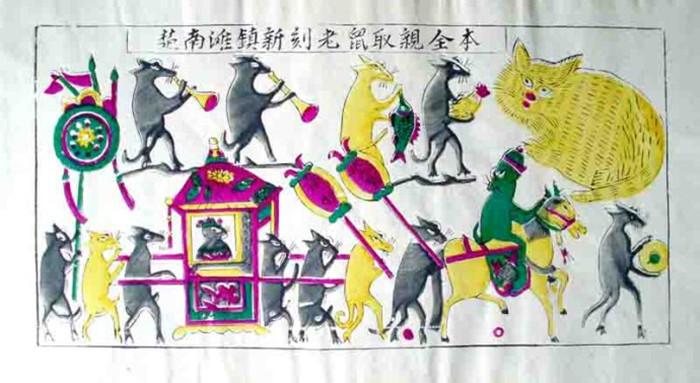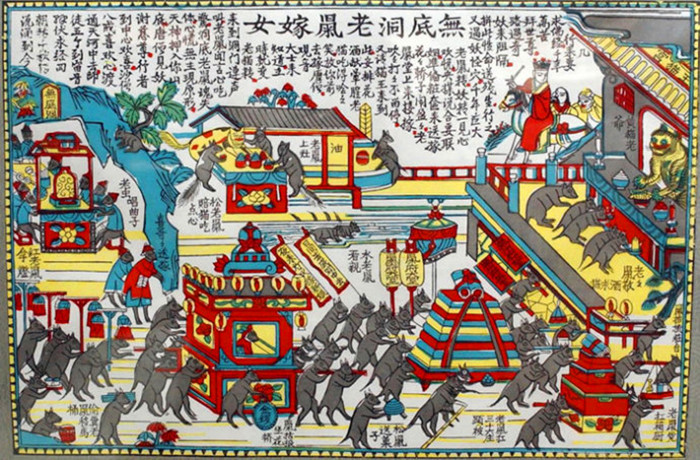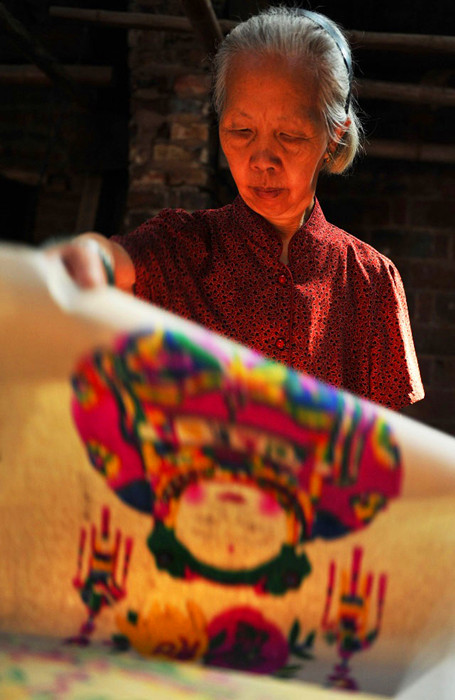The Lost New Year Picture
Source:Shaoyang International CultureWriter:Peng YanzhiTime:2014-12-30Clicks:次

Someone once said the New Year picture was the Spring Festival posted on the door.
‘Orchids, lotuses, chrysanthemums and plums are in full bloom on walls, filling the house with fragrance, which invite swallows and sparrows to sing under eaves and then fly straight into the house with vibrating wings.’ This is a folk poem about the New Year picture, describing the jubilant scene of every household welcoming the New Year’ s arrival through posting New Year pictures. At such a season, enjoying the smell of the New Year picture, people will feel that the next year is promising.

Soon after the block printing was invented at the end of the Tang Dynasty, the New Year picture appeared. On gates and doors in streets and lanes, New Year pictures took on a kind of bright and happy redness. Some people prayed for safety by posting the picture of warriors Qing Shubao and Yu Chigong one on the left and the other on the right, both of whom looked mighty and powerful with sword-like eyebrows, big round eyeballs and long flying hair on the temples, wearing helmets, armors and black leather boots. Some people wanted auspiciousness and then they posted the pictures of ‘Harmony Leading To Good Luck’, ‘Gold And Jade Filling The Hall’ and such likes, which reflected people’ s yearning for good life. Still other people posted such pictures as ‘Bowing An Umbrella At The West Lake’ and ‘Setting Brotherhood In The Peach Garden’ telling old lively popular historical stories or fairy tales.

The Near Year picture used bright and beautiful colors, plentiful and exaggerated designs and simple but unique skills to reflect people’ s optimistic feelings and colorful social phenomena.
The picture of ‘The Mouse Marrying A Wife’, which Lu Xun referred in his book ‘Morning Flowers Picked At Dusk’ and thought to be extremely valuable, just came from my hometown Tantou. The Dongting Lake & Xiang River culture with a long history and the unique folkways of central Hunan not only provided materials for Tantou New Year pictures but also bred their humanistic contents.
Being in glory in the early years of the Chinese Republic, Tantou New Year pictures experienced more than a hundred years of rise and fall through wind and rain.
Tantou New Year pictures, though simple without deliberate decorates like a pretty girl in the countryside, were extraordinarily splendid owing to their uniquely consummate skills. Picture makers were particular about paper, colors and color-mixing. The paper to be used to print pictures on were that made from local bamboo. This kind of paper, called ‘jade paper’ because of its natural milk-white color, had a unique quality quite different from any other kinds. Bright colors like red, blue and green made by hand were printed closely layer to layer in pictures. And the water to be used to mix colors was local underground water added with the water filtered when producing bean curd, so the mixture was pure and natural. In those years, Old Tantou Town attracted countless admirers of Tantou New Year pictures, which were shipped to all parts of the country with the ringings of bells on carriages and camels.
The intention of posting New Year pictures to greet the New Year’s happiness has not changed, but the development of modern society left the New Year picture gradually forgotten. When large red lanterns hang high from ceilings or under eaves with gold-colored Spring Festival couplets decorating gates and doors, how many people will recall the ages with New Year pictures overwhelming.

In Tantou, there used to be over a hundred workshops producing New Year pictures but now only two or three are struggling to survive with just two or three master makers. Skills are lost and sells are bad, because people’ s ideas have changed. Tantou New Year pictures coming from the old town become strangers when put in modern prosperous cities. Although the government are making all efforts to save this folk cultural heritage, Tantou New Year pictures feel a bit shameful in presence of reality.
Only the few people are still holding fast to this cultural treasure. One is old Gao Namei, now in her seventies, who is shakily accompanying Tantou New Year pictures as her life-long mate. Talking about the fate of the New Year picture, she felt that she could do nothing for it.
In today’ s old Tantou Town, where there stood New Year picture workshops, one can see only stone steps with green mosses, wooden gates full of dust, white walls broken and old picture makers lonely, and one will have a strong feeling that the glorious times are forgotten. All seen and felt appear to weep over the past prosperity.

(translated by Yi Daoqun)
- 上一篇:Ten misrepresented slang terms
- 下一篇:没有了
